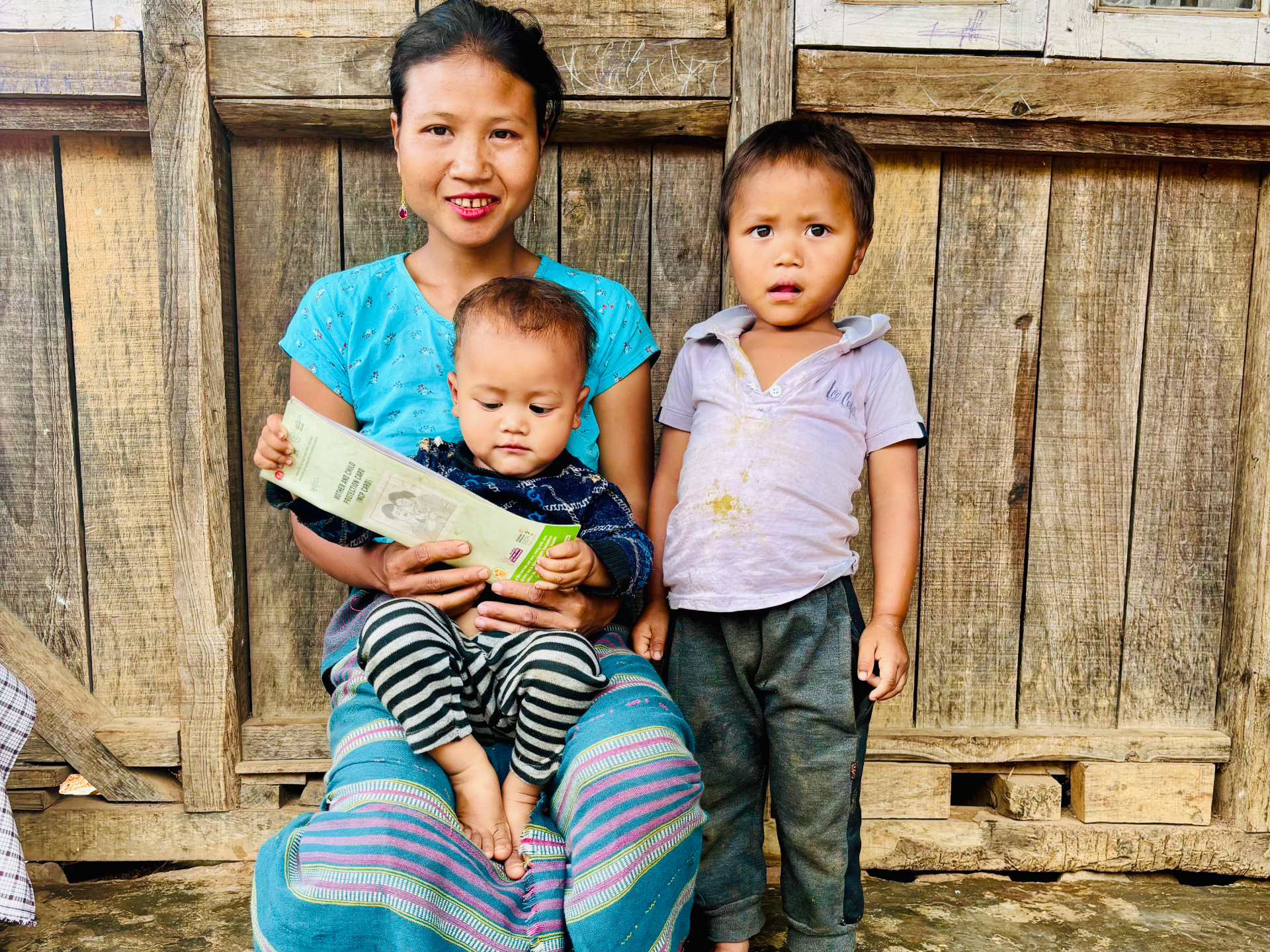Ms Sbian Kurbah, 32, lives in Lum sohpetbneng village in the Ri Bhoi district of Meghalaya with her four children and husband, who farms and keeps chickens. All four children were born at home, but the older three – the youngest is 20 months old and the oldest is 11 years old – did not receive timely immunization because of vaccine hesitancy.
Three years ago, when health workers from State Dispensary Umiam visited her home to request her to get her children immunized, Ms Kurbah used a stick to chase them away. The team, led by Dr Mariabiang K. Diengdoh, medical and health officer, left but did not quit. Over the next many months, they continued non-agenda visits to her home to build trust.

Ms Sbian Kurbah’s youngest son Batskhemlang (holding his immunization card) was born at home Lum sohpetbneng village in Meghalaya like his three other siblings. But unlike them, he received timey immunization because the health workforce from Barapani State Dispensary Umiam, Ri Bhoi district, addressed the family’s vaccine hesitancy concerns. (Photo: Sanchita Sharma / © WHO India)
It took time but they got results. All four children are now immunized and Ms Kurbah offers the team a traditional welcome with water and betelnut. “When is the next outreach session being organized?” she asks Dr Diengdoh, as she gives him her children’s immunization cards for review.
“The reason for our success was consistency. We kept going back to address her concerns and dispel rumours. When she said polio drops made children sterile, we pointed out that people in the village who had polio drops as children are parents now. She feared multiple injections in a single session, we offered to space them,” said Dr Diengdoh.
A surveillance medical officer from WHO National Public Health Support Network (NPSN) Shillong unit accompanies the team for monitoring support. WHO NPSN is providing technical and monitoring support for routine immunization and vaccine-preventable diseases to the Government of Meghalaya. Under the Government of India’s Universal Immunization Programme, close to 2.67 crore children and 2.9 crore pregnant women are immunized free of cost against 12 vaccine-preventable disease annually.

Staff nurse Ms Rimaia L. Mairang (left) with Ms Shaidalin Matlang, 34, who has brought her 8-year-old son Shim Kibor to the State Dispensary Umiam for medicine to treat tongue thrush. (Photo: Sanchita Sharma / © WHO India)
Lum sohpetbneng can be reached by travelling 6 km up a steep road, with the closest dispensary in Umiam about 8 km away. With the torrential rains disrupting connectivity during the wet season from May to October, medical officers and staff nurses from the state health department organize outreach health sessions and home visits to ensure people get the primary health care they need. ASHAs (village health volunteers) and angawanwadi workers (rural child carers) from Child Development Services Scheme further mobilize the community to seek health services.
Home deliveries are high because of connectivity issues. Like Ms Kurbah, Ms Enejuncy Sun, 33, also delivered all her five children at home and needed a lot of convincing to agree to get them immunized. Her youngest son, born in September 2022, had just received BCG vaccine for protection against childhood tuberculosis till the Umiam team visited her home and persuaded her to get her children immunized.

WHO surveillance medical officer from Shillong with Dr Mariabiang K. Diengdoh (extreme right) and his team from State Dispensary Umiam, updating Ms Enejuncy Sun about the primary health services available at monthly session sites. (Photo: Sanchita Sharma / © WHO India)
“Three years ago, this was a high-risk area with poor health-seeking behaviour and low immunization coverage, with chronic refusal in four households. We visited families in their homes to identify the reasons for denial, the reasons were not the same. We mobilized the Village Health Council, organized meetings with the community. We even organized a Baby Show for children below two years in March 2024 to engage with mothers of young children. Along with information, we gave feeding bowls and containers to participants,” said Dr Diengdoh.
High community engagement slowly led to behaviour change. “The change occurred last 2023, and immunization really picked up,” said Dr Diengdoh. The team also ensures all beneficiaries get the four key messages to prepare them about what to expect. “We tell them about the vaccine being given and the disease prevented; potential discomfort/fever following vaccination and how to manage it, updating of immunization card during visit; and information about the next date for vaccination date, time, location and importance,” said Ms Budlin Shabong, community gender and health activist.

Children on their way home from school photobomb the Lum sohpetbneng Village Health Council meeting, which identifies needs and gaps in services and shares them with district medical officers. (Photo: Sanchita Sharma / © WHO India)
The Lum sohpetbneng Village Health Council has 23 members – 13 men and 10 women – who routinely meet the district health officials to identify and address the needs and gaps.
“The health council meets once a month. The medical team from Umiam often comes with the block development officers, who share updates on development activities and schemes related to village roads, transportation, agricultural development, check dams, Village Health Council funds, and more. This is really useful, we discuss challenges and identify solutions,” said Mr Nebarius Kharsahnoh, village headman.
“People prefer coming to outreach health sessions as they get several services in one place. Even when the block development officer’s team is not there, people are screened for hypertension and diabetes and treated for fever, infections, anaemia, and given iron and folic acid.,” said Ms Shabong.
